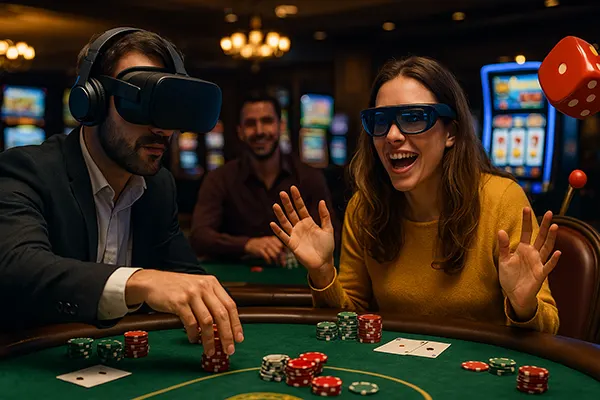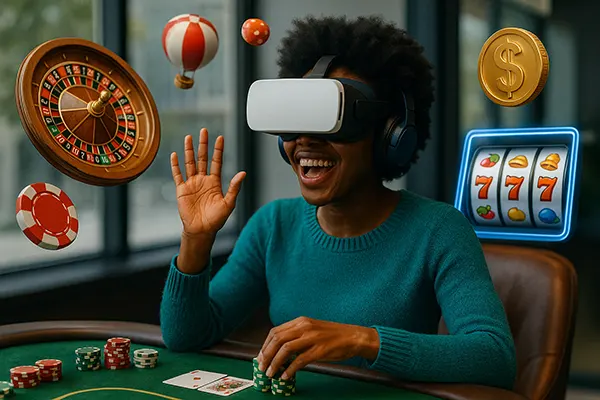
The Impact of Virtual and Augmented Reality on the Social Aspect of Gambling
Virtual Reality (VR) and Augmented Reality (AR) technologies have transformed many industries, and gambling is no exception. By 2025, these innovations have become more sophisticated, offering immersive and interactive environments that significantly influence how people connect, compete, and communicate in gambling settings. The impact extends beyond simple gameplay, shaping communities, behaviours, and even perceptions of responsible gaming. Understanding this social transformation is essential for players, operators, and policymakers.
Enhanced Social Interaction in Immersive Environments
VR and AR have introduced gambling spaces where players interact with one another in real-time, regardless of geographical location. In VR casinos, for example, users can communicate via voice chat, observe each other’s avatars, and even read body language cues, creating an atmosphere that resembles a physical gambling hall. This digital social layer helps replicate the excitement and camaraderie traditionally found in land-based venues.
These virtual environments encourage collaborative and competitive experiences. Multiplayer poker rooms, roulette tables, or slot tournaments within VR spaces allow participants to form teams, join groups, and compete together. This not only strengthens community bonds but also fosters long-term engagement among players who return for the social experience as much as for the games themselves.
AR further enriches this interaction by integrating digital game elements into the player’s real-world surroundings. Players can invite friends into their AR-enhanced living room for a shared blackjack session or project live statistics and leaderboards onto physical objects. This blending of physical and digital space adds depth to interactions and encourages social participation.
Building Global Gambling Communities
One of the most significant social outcomes of VR and AR integration in gambling is the emergence of global communities. By removing the physical barriers of traditional gambling venues, players from different cultures and countries can gather in shared virtual spaces. This exposure to diverse perspectives promotes cultural exchange, new friendships, and even collaborative events, such as international charity tournaments hosted entirely in VR.
Moreover, these communities often extend beyond the games themselves. Players form online groups, attend virtual meet-ups, and maintain ongoing communication through integrated social platforms. In 2025, VR poker clubs and AR-based slot leagues are common examples of how the gambling industry has become a networking hub for enthusiasts worldwide.
However, the creation of global communities also comes with challenges. Operators must address issues such as language barriers, cultural sensitivities, and time zone differences to ensure inclusive participation. Successful integration requires thoughtful design and moderation to maintain a safe and respectful environment for all participants.
Psychological and Behavioural Implications
While VR and AR create more engaging and socially connected gambling experiences, they also influence player behaviour in significant ways. The immersive nature of VR environments can heighten emotional responses, making wins feel more exhilarating and losses more impactful. This heightened emotional engagement can strengthen social bonds but may also increase the risk of impulsive behaviour.
Social presence in these environments can act as both a motivator and a pressure factor. Friendly competition may encourage responsible participation, but peer influence might lead some individuals to take greater risks. Understanding these dynamics is essential for developing responsible gambling strategies that address both the benefits and the potential downsides of social interaction in VR and AR gambling.
In AR contexts, the integration of gambling elements into everyday surroundings can blur the boundaries between leisure and real life. This constant accessibility requires operators to implement clear boundaries, such as scheduled play reminders or limits on AR-based interactions, to protect players from excessive engagement.
Responsible Gaming Measures in the VR/AR Era
By 2025, many operators have embraced advanced tools to promote responsible gaming in VR and AR spaces. These include AI-driven behaviour tracking systems that detect signs of problem gambling, real-time notifications to encourage breaks, and integrated support channels where players can access help without leaving the game environment.
Social interaction features also provide opportunities for peer support. Players in VR casinos can flag concerning behaviour among peers, enabling moderators to intervene early. Additionally, community guidelines and in-game reporting tools help maintain safe and respectful communication channels.
Transparency about game mechanics, odds, and potential risks is more important than ever in these immersive spaces. Clear visual indicators and interactive tutorials ensure that all participants, regardless of their familiarity with VR or AR, can make informed decisions about their gameplay.

Future Outlook and Technological Advancements
Looking ahead, VR and AR gambling is expected to become even more socially dynamic, with advances in haptic feedback, photorealistic avatars, and AI-driven personalisation enhancing the user experience. These developments will further integrate gambling into broader virtual ecosystems, where entertainment, social networking, and competitive play coexist seamlessly.
We can also expect a stronger link between VR/AR gambling and other digital trends, such as the metaverse and blockchain-based economies. Players may soon carry persistent digital identities across multiple gambling environments, maintaining social connections and reputations wherever they choose to play.
However, the growth of VR and AR gambling will require ongoing regulatory attention. Issues such as identity verification, cross-border legal compliance, and ethical AI use will remain critical to ensuring safe and equitable access to these experiences. Balancing innovation with responsibility will define the next phase of social evolution in gambling.
Integration with Broader Digital Lifestyles
In 2025, VR and AR gambling is no longer an isolated activity but part of a broader digital lifestyle. Players often transition between gaming, virtual concerts, and social events without leaving the same immersive environment. This convergence of activities creates opportunities for cross-industry collaboration, such as partnerships between gambling operators and entertainment brands.
Such integration also enhances user retention. When gambling is embedded within a larger network of virtual social spaces, players are more likely to remain engaged for longer periods. This, however, reinforces the importance of maintaining healthy boundaries and offering tools for self-regulation.
Ultimately, VR and AR have redefined the social fabric of gambling. They have created new opportunities for connection, collaboration, and cultural exchange, while also introducing challenges that require thoughtful solutions. The coming years will determine how these technologies shape not only how people play but also how they interact, learn, and build communities within gambling environments.
